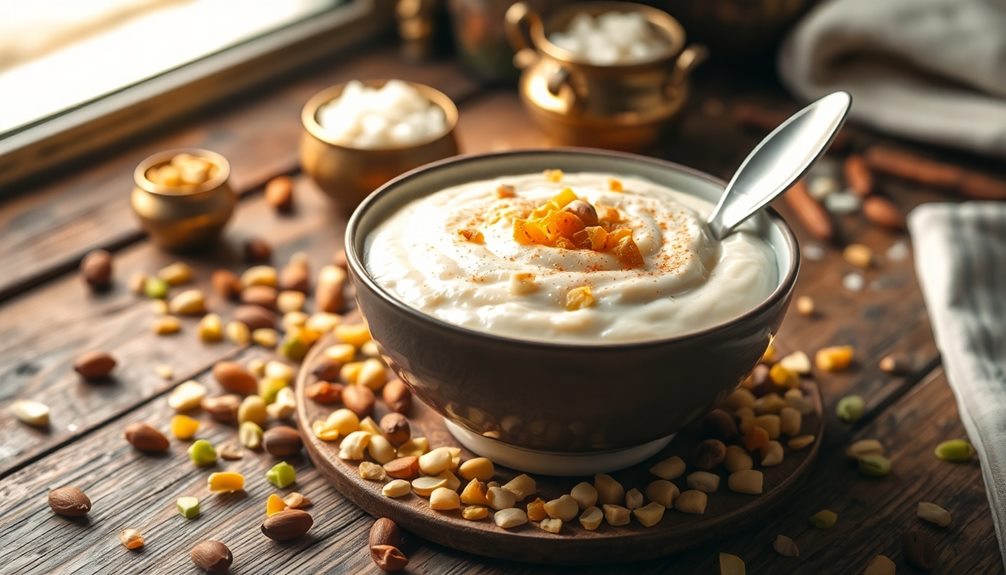Exploring the regional spice routes of Indian garam masala reveals how trade shaped its unique flavors. Northern blends incorporate cinnamon, cloves, and cardamom from Middle Eastern routes, while southern varieties feature black pepper and dried chilies from Southeast Asia and Africa. Eastern spices like nutmeg and mace come from the Spice Islands, and Himalayan blends include medicinal ingredients from Tibet. Continuing your journey will uncover even more fascinating connections behind these rich, diverse spice profiles.
Key Takeaways
- Northern Indian garam masala is influenced by Arab trade routes, introducing spices like cinnamon, cloves, and cardamom.
- Southern coastal blends incorporate black pepper and dried chilies from Southeast Asian and African maritime trade.
- Eastern spices such as nutmeg, mace, and dried fruits reflect connections with the Spice Islands and trade routes.
- Himalayan blends include medicinal spices like turmeric and dried ginger, traded through Tibet and Central Asia routes.
- Regional processing techniques and cultural practices shape the unique flavor profiles influenced by historical trade interactions.

Indian garam masala is a vibrant blend of spices that varies considerably across regions, reflecting local tastes, climate, and trade histories. When you explore these regional variations, you notice how historical trade influence plays a pivotal role in shaping flavor profiles that are distinct yet interconnected. Long ago, trade routes such as the Silk Road and maritime routes brought spices from distant lands like Southeast Asia, Africa, and the Middle East into India. These exchanges introduced new ingredients and blending techniques, which local communities adopted and adapted over generations. As a result, each region’s garam masala bears the mark of its unique trade history, creating a tapestry of flavors that tell stories of commerce and cultural exchange.
In northern India, garam masala often features warm, robust spices like cinnamon, cloves, and cardamom, reflecting the influence of Arab traders and the spice’s historical importance in Mughal cuisine. These spices were highly valued and traded extensively, which made them integral to the region’s culinary identity. Moving southward, the coastal areas incorporate more coastal and tropical spices such as black pepper and dried chilies, thanks to trade links with Southeast Asia and Africa. These regions developed flavor profiles that are often zestier and more aromatic, influenced by the availability of local ingredients and trade goods. The western regions, including Gujarat and Rajasthan, showcase garam masala blends that emphasize earthy, smoky notes with cumin, coriander, and dried herbs, influenced by trade interactions along the Arabian Sea and Middle Eastern markets.
You’ll also find that the eastern regions, like Bengal, include ingredients such as nutmeg, mace, and dried fruit, which were traded from the Spice Islands and beyond. These elements lend a sweeter, more complex dimension to their garam masala, revealing a different chapter in India’s spice trade history. Additionally, the incorporation of medicinal spices like dried ginger and turmeric in Himalayan blends reflects both culinary and healing traditions, shaped by trade routes crossing through Tibet and Central Asia. These spices were valued not only for their flavor but also for their health benefits, further diversifying regional profiles. Furthermore, the variation in processing techniques across regions highlights how local culture influences spice blending and preparation methods, adding another layer to the rich diversity of Indian garam masala.
Frequently Asked Questions
How Do Regional Variations Affect Garam Masala’s Flavor Profile?
Regional variations greatly influence garam masala’s flavor profile through different spice blending techniques and flavor preservation methods. You’ll notice that in some areas, spices are roasted to enhance aroma, while others favor grinding fresh for a brighter taste. These local practices affect the balance of warmth, heat, and complexity. By understanding these nuances, you can tailor your spice blends to reflect authentic regional flavors, making your dishes richer and more vibrant.
Which Specific Spices Are Unique to Certain Indian Regions?
Did you know that cardamom, often called the “queen of spices,” is mainly cultivated in the Western Ghats? In regional spice markets, you’ll find star anise in the North, turmeric in the South, and fennel in Gujarat. These spices are unique to their regions due to distinct regional spice cultivation practices, shaping the flavors of local garam masala. Your culinary journey can truly reflect India’s diverse spice heritage.
How Has Historical Trade Influenced Garam Masala’s Ingredients?
You see, historical trade has greatly shaped garam masala‘s ingredients. Ancient trade networks facilitated cultural exchanges, introducing new spices from distant lands. These exchanges allowed Indian cooks to blend locally sourced spices with those brought in through trade, creating complex flavors. As a result, garam masala reflects a fusion of regional ingredients influenced by centuries of trade, making it a unique spice blend that embodies India’s rich history of commerce and cultural interaction.
Are There Traditional Methods for Sourcing Spices Along These Routes?
You’ll find that traditional spice markets play a vital role in sourcing indigenous ingredients for garam masala. Traders and local farmers use time-honored methods like direct trade and community exchanges to guarantee authenticity. These practices help maintain the quality and regional flavors of spices, preserving the cultural heritage behind each blend. By relying on traditional markets, you get access to fresh, locally-sourced ingredients that truly reflect the spice routes’ historic essence.
How Do Regional Climates Impact Spice Cultivation for Garam Masala?
Climate changes can considerably sway spice cultivation, impacting both crop diversity and quality. You’ll find that regional climates demand careful climate adaptation, as hot, humid areas boost different spices than cooler, drier zones. These climatic conditions influence when and how spices grow, shaping the flavors in your garam masala. By understanding these environmental nuances, you appreciate the diverse spice sources that bring vibrant flavors to your favorite blends.
Conclusion
As you savor the vibrant flavors of Indian garam masala, remember it’s more than just a spice blend—it’s a journey through centuries-old trade routes. While the spices may have traveled vast distances, their rich aromas and cultural stories remain rooted in local traditions. Just as these routes connect distant lands, your cooking connects history with your palate, turning simple ingredients into a celebration of India’s diverse culinary heritage. So, embrace the spice, and let your dishes tell their story.









